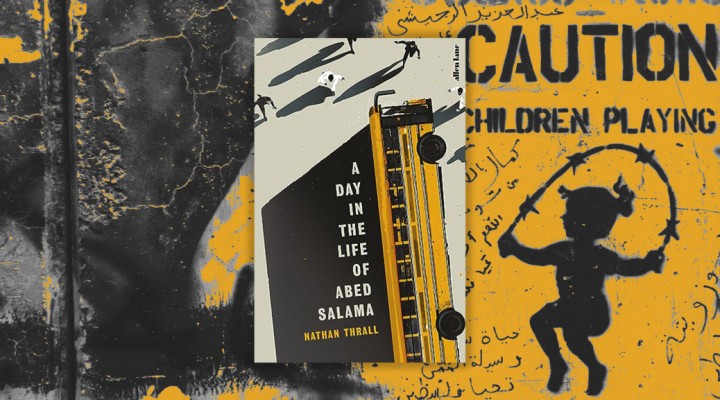A Day in the Life of Abed Salama: Remembering tragedy and colonial struggle in Palestine

A Day in the Life of Abed Salama: A Palestine Story reveals the impact of Israeli colonial violence through the Jaba bus tragedy and its aftermath.
A day in Palestine shows the harsh reality of Israeli colonial violence. This becomes clear right away in Nathan Thrall’s non-fiction book, A Day in the Life of Abed Salama: A Palestine Story (Penguin, 2024).
The book tells the story of the Jaba bus accident northeast of Jerusalem in 2012, connecting different people and events within the broader context of Israeli colonialism, military occupation, and settlement expansion.
Thrall’s book is based on interviews with relatives of the victims and witnesses. It is well-documented to show the history and reality of Palestinian lives under Israeli settler-colonialism and violence. It highlights the impact of colonial politics on the people and how Palestinian lives are continuously harmed.
“News fragments the Palestinian experience. Through a single tragedy, Thrall’s book brings the Palestinian story together, revealing the bigger picture”
“The weather is not good today,” Abed Salama’s wife, Haifa, thought as their son Milad left for a school outing on the day of the accident.
Shortly after, the school bus, forced to take a dangerous route because of Israel’s apartheid infrastructure, collides with a semitrailer. Salama is alerted to the accident and rushes to the scene.
“They carried the burned bodies out of the bus and laid them on the ground,” a corrupt Palestinian Authority (PA) security officer told Salama.
The book shifts between past and present, telling the stories of several people affected by the tragedy.
Salama, who lives in Anata, is the main character.
The first part of the book focuses on his personal life and the trauma caused by Israeli restrictions on movement and education, his work in Jewish settlements, his mistrust of the Palestinian Authority (PA), the Palestinian intifadas in the occupied West Bank, and the Oslo Accords.
All of this is set against the backdrop of the 1948 Nakba, which led to the ongoing displacement of Palestinians that continues to this day.
The occupied West Bank, synonymous with the Palestinian Authority, is given prominence in the context of state-building.
However, Thrall’s book breaks this diplomatic and sanitised image to show the reality of living on fragmented land taken by settlements and settlers.
It reveals the political violence of surveillance, security services, and Israeli checkpoints, and how all this translates into unending daily oppression for Palestinians, costing lives.
The accident is one part of the story. Through it, readers see the traumatic lives of Palestinian civilians.
Emergency services couldn’t reach the burning vehicle on time due to Israel’s military occupation and its restrictions, resulting in the deaths of eight Palestinians, including seven children.
Thrall makes it clear that despite any shortcomings regarding the outing and the vehicle used, Israel’s responsibility for the tragedy is undisputed.
It is to this effect that the book explains the politics affecting the characters’ lives, the roles they play or could have played in their communities, and the impact of Palestinian politics, as the PA collaborates with Israel and the international community.
The Jaba bus accident starkly shows how little Palestinians’ lives matter to Israelis.
Israeli ambulances could have reached the scene sooner, but volunteers arrived before the medical services despite the road being under Israeli control.
Through the accounts of those who helped, the rest of the occupied West Bank comes into perspective – the Negev, Khan al-Ahmar, Palestinian prisoners, and the raids Israel conducted on the PLO in Tunisia.
News fragments the Palestinian experience. Through a single tragedy, Thrall’s book brings the Palestinian story together, revealing the bigger picture.
Like Salama, whose history is first explored in the book, particularly the details of his marriages and lost love, other characters are living their own personal traumas.
Salaah, a child who was also on the bus on the day of the accident, told his mother Nansy forty days before the accident that he was going to die.
This ominous foreboding was reflected in Haifa’s thoughts on the day of the accident. A family that was already broken fell apart, as in Nansy’s case, leading to abuse, coercion, and divorce.
“The accident had ruined Nansy’s life and destroyed her family, but she didn’t think she was unusual,” Thrall writes. “It had crushed every family, each in its own way.”
“Thrall’s narrative uncovers the layers of colonial violence, ongoing land grabs, and the disparities between settlements and Palestinian enclaves, between settler colonists and the indigenous colonised Palestinians”
Amid all the pain for the families, the PA took advantage of photo ops, visiting the wounded in the hospital.
Its ministerial committee, while listing the inadequacies, failed to consider that both Israel’s military occupation and the PA’s collaboration with Israel were responsible for the conditions that led to the tragedy.
The bus accident represents the fatality and tragedy of the situation. Yet, the story is more complex than that single event.
Thrall’s narrative uncovers the layers of colonial violence, ongoing land grabs, and the disparities between settlements and Palestinian enclaves, between settler colonists and the indigenous colonised Palestinians.
The realisation remains that all this could have been avoided, but nothing ever is, because diplomacy never challenges Israel’s impunity.
https://www.newarab.com/features/day-life-abed-salama-palestine-story
 TheAltWorld
TheAltWorld 
0 thoughts on “A Day in the Life of Abed Salama: Remembering tragedy and colonial struggle in Palestine”